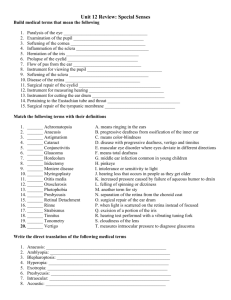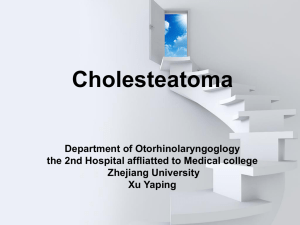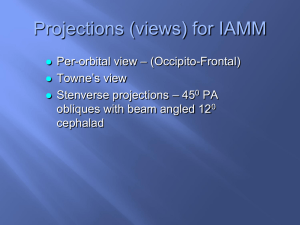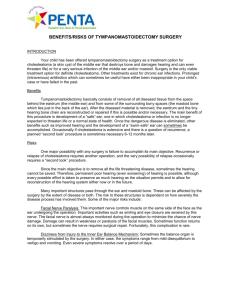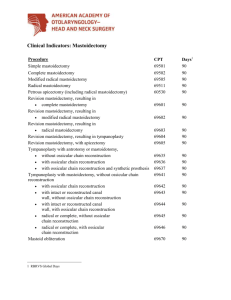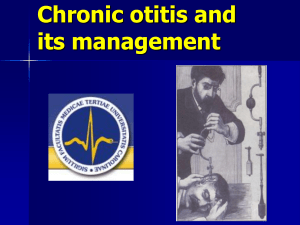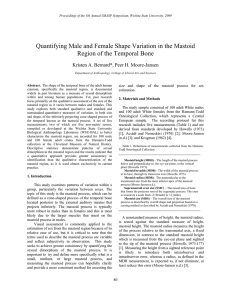Chronic Ear Disease - UCLA Head and Neck Surgery
advertisement
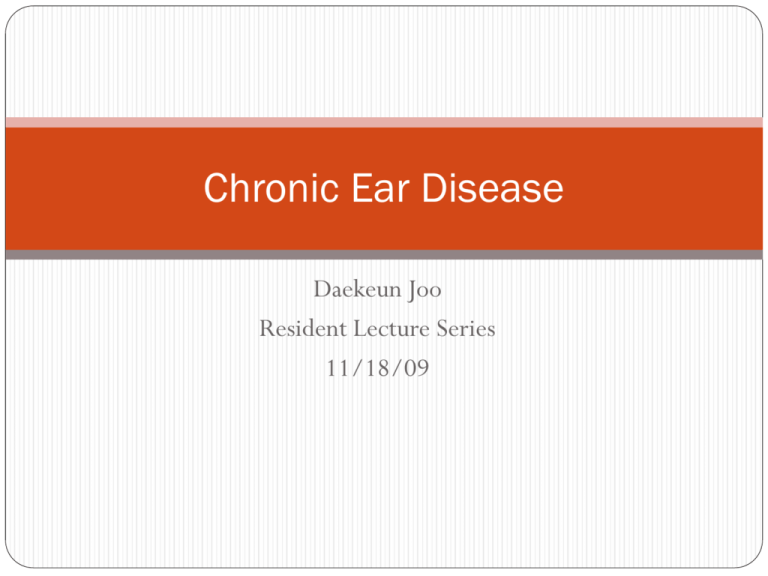
Chronic Ear Disease Daekeun Joo Resident Lecture Series 11/18/09 ETD URIs Viral-induced damage to ET lining resulting in decreased mucociliary clearance Viral invasion of ME mucosa results in inflamm Reflux of NP bacteria through ET causing infection of ME Allergies causing ME & ET inflammation Anatomic abnormalities such as cleft palate or other craniofacial abnormalities 3 Physiologic functions of the ET Ventilation or pressure regulation of the middle ear 2. Protection of the middle ear from NP secretions & sound pressures 3. Clearance or drainage of middle ear secretions in to the NP 1. Cholesteatoma Squamous epithelium trapped w/in skull base, t-bone, middle ear or mastoid Bone erosion occurs by 2 mechanisms: 1. Pressure effects (applied consistently over a long period of time) produce bony remodeling 2. Enzymatic activity at the margin of the chole enhances osteoclastic activity (increased when chole becomes infected) Management In the early half of the 20th century, cholesteatomas were managed by exteriorization (i.e. mastoid air cells exenterated, posterior EAC removed & ear canal widened) – CWD approach In the 1950s & 60s, the House Clinic really clarified the anatomy of the facial recess to access the ME w/o taking the canal wall down Goals of surgery for cholesteatoma To make the ear safe by eliminating all chole & chronic infection To make the ear problem-free for all usual activities of daily living including swimming Conserve residual hearing To improve hearing if possible Patient with cholesteatoma in an onlyhearing ear…what is the management? CWD mastoidectomy with complete removal of chole CWD mastoidectomy with exteriorization of chole CWU mastoidectomy with 2nd look in 6-9 months No surgery 3 Types Congenital – squamous epithelium trapped w/in t-bone during embryogenesis (usually found in ant. mesotympanum or periET area) Primary acquired – arise as a result of TM retraction. Can occur in the epitympanum or posteriorly enveloping the stapes & retracting into the sinus tympani Secondary acquired – occur as result of injury to the TM (i.e. AOM, trauma, even PE tubes) What is the most common cause of continuous otorrhea in a patient that’s already had a CWD mastoidectomy? Facial recess not drilled out enough Remnant sinodural angle cells Cholesteatoma left in sinus tympani What is this? Keratoma obturans Primary acquired cholesteatoma Secondary acquired cholesteatoma Primary cholesteatoma A patient comes in with severe OE, pain and CN VII palsy, what is the best imaging modality for dx? CT MRI Radionucleotide scan A pt inadvertently has a TM retraction pocket extending into the sinus tympani transected during middle ear exploration. The TM defect was repaired with a graft. Which postop complication is he at greatest risk for? Chole in epitympanum lateral to incus Chole in mesotympanum medial to incus Perilymphatic fistula at oval window Damage to the lateral semicircular canal CSOM Chronic serous OM is defined as a MEE w/o perforation that persists > 1-3 months Chronis suppurative OM is a perforated TM w/ persistent otorrhea >6-12 wks Pseudomonas, S. Aureus, Proteus and K. Pneumoniae are most common Medical vs. Surgical Management Treatment aims include: antibiotic gtt, regular aggressive aural toilet and control of granulation tissue Indications for surgery in CSOM include: perf > 6 wks, otorrhea > 6 wks despite gtts, chole, CT e/o chronic or coalescent mastoiditis, CHL Child with OM & opacified mastoid air cells on CT but no coalescence. Cx not helpful and pt spiking temps despite 3 days of IV Abx… Radical mastoidectomy Complete mastoidectomy Simple mastoidectomy Antibiotic drops and steroids 5 Types of T-plasties (Wullestein) Type 1 – simple closure of TM w/o OCR Type 2 – any kind of OCR involving malleus, incus or both Type 3 – placing TM graft over stapes head Type 4 – stapes head absent but footplate present, so footplate is exteriorized to mastoid & graft is placed over it Type 5 – fenestration operation (not done anymore) Types of Mastoidectomies Cortical mastoidectomy – removal of mastoid cortex & exteriorization of mastoid air cells CWU – can be used to eradicate chole through a facial recess approach Modified radical – CWD, but the ossicles & TM remnants are preserved for hearing recon Radical – ME & mastoid are exteriorized into a single cavity. Ossicles removed except stapes footplate & ET closed off. When performing a mastoidectomy, drilling too deep during a facial recess approach can result in injury to which structure? Posterior semicircular canal Lateral semicircular canal Chorda tympani Mastoid segment of facial nerve What is the most common complication of revision cholesteatoma surgery Labyrinthine fistula Facial nerve injury TM perforation Hearing loss While in surgery the surgeon notes that the cog has been eroded by chole, what is the most likely other structure affected? Lateral semicircular canal Vertical segment of FN Labyrinthine segment of FN Tympanic segment of FN Which of the following theories on the pathogenesis of acquired chole does not exist? Invagination of the tympanic membrane Transdifferentiation Basal cell hyperplasia Epithelial ingrowth through a perforation Squamous metaplasia of middle ear epithelium The diagnosis of petrous apicitis is suspected by…. Scintigraphy Plain X-Ray Surgical exploration Clinical grounds and CT Tympanometry It has been observed that pts with a h/o COME have… More sclerotic mastoids w/ decreased pneumatization compared w/ healthy pts Less sclerotic mastoids with decreased pneumatization compared w/ healthy pts More sclerotic mastoids w/ increased pneumatization compared w/ healthy pts Less sclerotic mastoids w/ increased pneumatization compared w/ healthy pts More sclerotic mastoids w/ absent pneumatization compared w/ healthy pts Tympanosclerosis is associated with… Atherosclerosis of the internal carotid artery Necrosis of the tympanic membrane Cholesteatoma History of otosclerosis Recurrent bouts of acute otitis media The End
